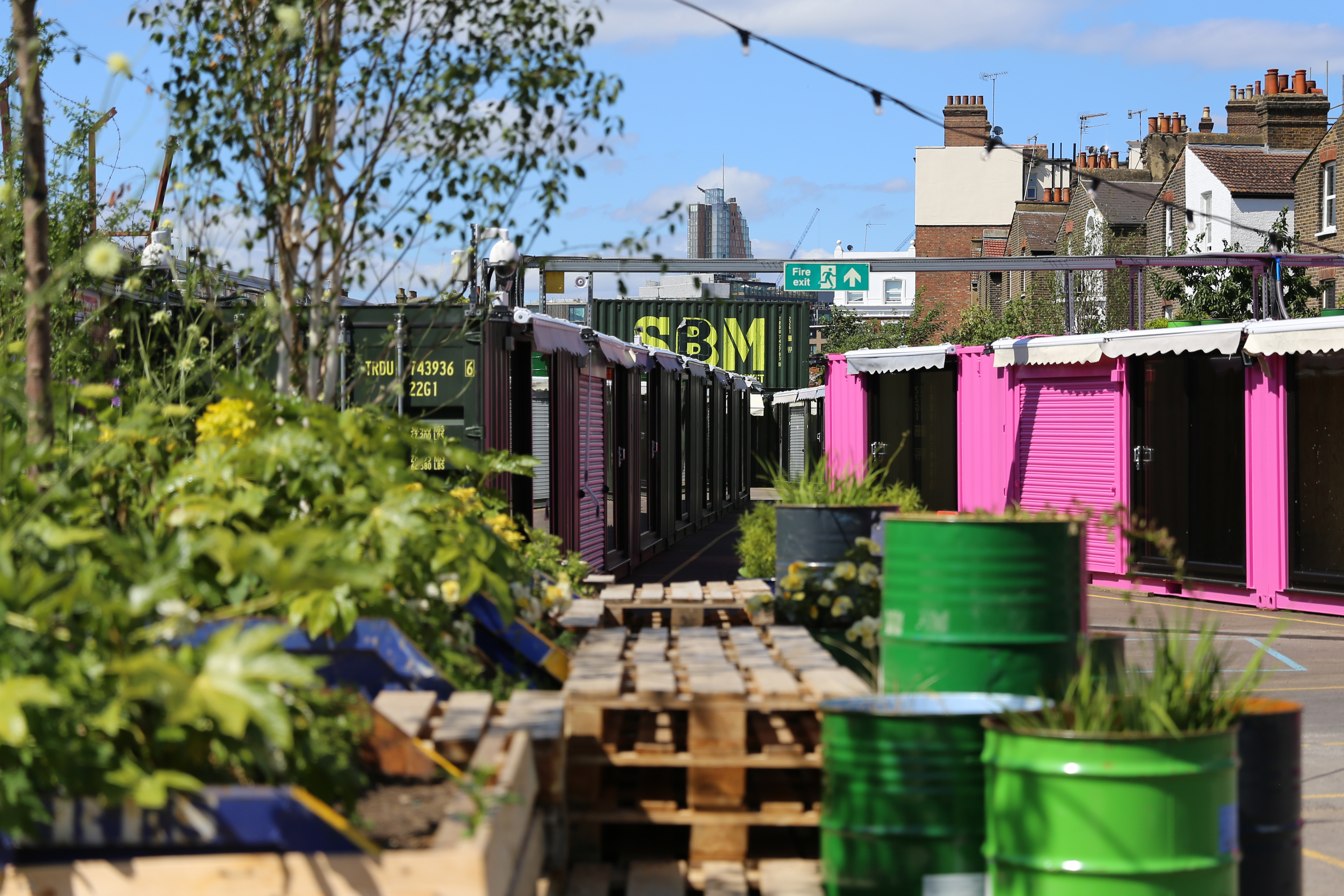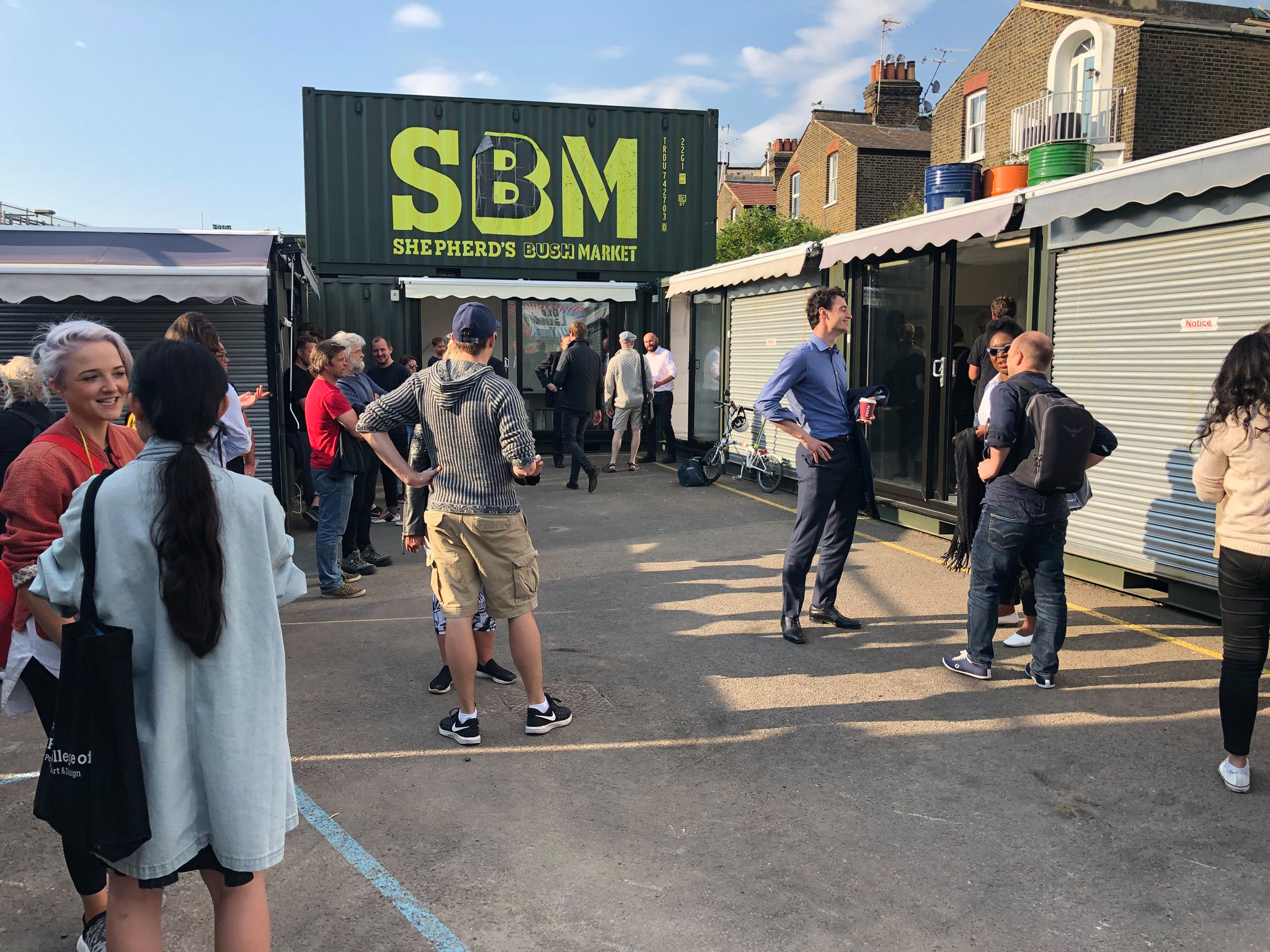In conversation with Helene Steiner, co-founder of Open Cell, London's cross-disciplinary 'bio-village'...
A shipping container village of startups innovating at the intersection of biology and design, might not be what you'd expect to find in the midst of London's Shepherd's Bush Market. But then, Open Cell is all about the unexpected: sustainable bioplastics, 'growing' buildings out of fungi, and for farmers struggling due to declining bee populations? Crop-pollinating swarms of flies controlled with an app. Experimental ideas that have sparked excitement amongst the high-profile scientists who are backing it.
The brainchild of Helene Steiner and Dr Thomas Meany, Open Cell was conceived whilst moonlighting as lecturers in biodesign at the Royal College of Art. Both Steiner, who was working at Microsoft Research and Meany, who was in the Biotechnology Department of Cambridge University, were struck by the talented students with incredible ideas but nowhere to develop them...

What is it about the interweaving of different fields that you find compelling?
On my first day at the Bauhaus University, my professor asked all “freshman”, if they thought that they'd be a product designer after University. I can remember that everybody raised their hand with excitement, including me. What he said next surprised me: ”Only half of you will be the designer you have in mind. The rest will find themselves in unexplored territories and fields that you can’t imagine, and some that don’t even exist yet.”
The walls between disciplines and fields are blurring and new fields are emerging out of this. A good example are new interfaces: interfaces between machines and humans and interfaces between humans and other living species. This intersection is for me the most compelling one where you can find innovations about to emerge.
During my time at Microsoft Research Cambridge, my mentor Asta Roseway, called this new kind of designer “Fusionists”. And the challenge and reward for the Fusionist is the ability to communicate, comprehend and connect all parties through design. Then, when we look at the global challenges that lie ahead, they can only be solved by a collaboration of minds and vocations, and a diversity of views.
“the walls between disciplines are blurring and new fields are emerging out of this”
How does Open Cell's 'bio-village' differ from working in a university lab?
In the past, biotech companies evolved mostly out tech-transfer from science universities. In the last year this trend has changed. In the UK, nearly half of all newly-formed biotech startups are formed outside a tech transfer office. And more and more of those companies emerge from outside of a traditional science background, such as Design and Engineering disciplines.
We found that there was a gap in the market for these new kind of biotech startups. Our shipping container village not only offers unique biology labs but offices and maker facilities, too. This helps our residents prototype faster and test their ideas. Our residents don’t fit in a box; neither do what they do.
But what really differs Open Cell from university labs is the transparency towards the public. People can wander through the village and take part in monthly events to explore the possibilities of biotechnology.
“our shipping container village helps resident startups prototype faster and test their ideas”
What biodesign innovations are you most excited about right now?
For me, the more design-led and consumer-facing innovations are highly exciting - such as Chip[s]Board, an Open Cell resident, who developed an eco-friendly alternative to plastic: MDF and chipboard made of 100% potato.
Another Open Cell resident I am excited about is Biohm. Biohm is challenging the construction industry and architecture. One of their best sellers is their mycelium insulation which is not only more environmentally friendly but also offers even better properties than current insulation materials. The material is even self-extinguishing. You can watch a pretty cool documentary about them on the BBC where they tried to melt chocolate ice-cream with a Bunsen burner.
There are many new fibres and materials on the rise that allow us to create a circular economy and which will challenge new manufacturing techniques. One of them is Colorifix from Cambridge. Colorifix is tackling the polluting fashion industry, especially the dying process, by developing bacterial dyes. I adore them for taking on the challenges of new production methods and for working hand-in-hand with the fashion industry. Their dress – created in collaboration with Stella McCartney - is currently on exhibit at “Fashioned from Nature” in London's V&A Museum.
How is Open Cell's location in the sci-tech superhub between London and Cambridge crucial to its inhabitants' success?
We have learned from our tenants that early-stage startups need to be connected to the matrix. They need to be close to the centre, other facilities and easy to visit, while being able to follow their preferred lifestyle.
The borough we have based ourselves in is evolving as a biotech hub with leading academic institutions such as Imperial College and the Royal College of Art, investors and accelerators such as Rebelbio, and big companies such as Novartis. But there was little to no infrastructure to help early-stage startups. Open Cell bridges the gap between research and companies.
“global challenges can only be solved by a collaboration of minds, vocations and a diversity of views”
What changes are afoot in the London biodesign scene?
More and more projects and startups will appear from non-traditional disciplines. Courses to prepare people for this will also appear, such as the new Biodesign Course at Central Saint Martins and the Bio-Integrated Design Course at UCL.
What's next for the constantly evolving Open Cell ecosystem?
We are excited to work further on how labs for the new biotech generation have to look like! What we have learned so far is that they have to be much more modular, affordable and flexible to adjust to the new possibilities of biotech.
For more - see www.opencell.bio
This article is a little bit outside of our core geography but it’s a really good example of innovation developing outside of traditional science and technology parks. This is very much in keeping with discussion at the UK Science Park Association meeting in January 2019 http://www.ukspa.org.uk/ which debated other approaches to building that doesn’t always mean shiny new, and expensive, buildings.

Topics



